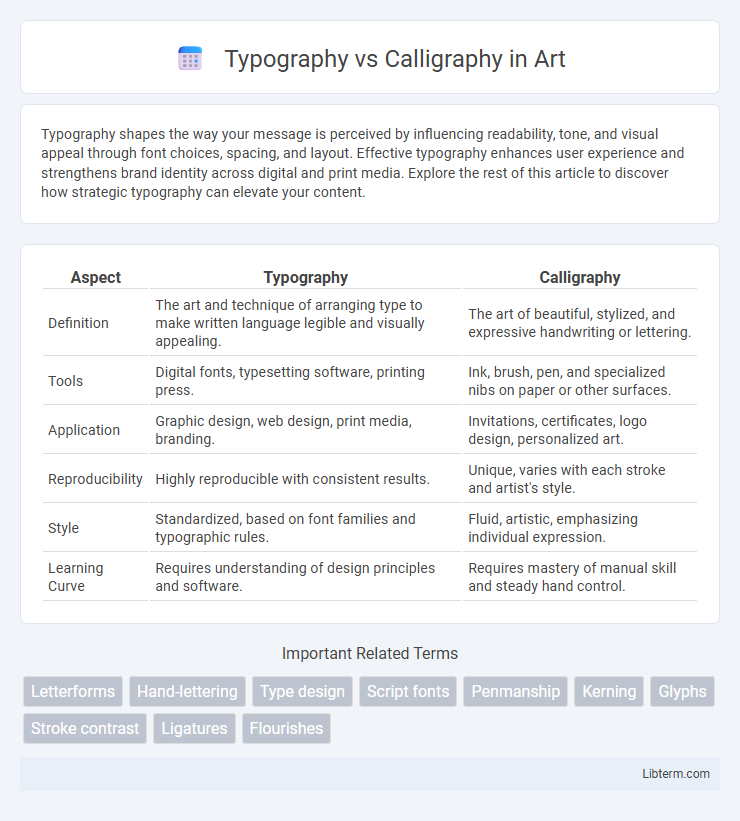Typography shapes the way your message is perceived by influencing readability, tone, and visual appeal through font choices, spacing, and layout. Effective typography enhances user experience and strengthens brand identity across digital and print media. Explore the rest of this article to discover how strategic typography can elevate your content.
Table of Comparison
| Aspect | Typography | Calligraphy |
|---|---|---|
| Definition | The art and technique of arranging type to make written language legible and visually appealing. | The art of beautiful, stylized, and expressive handwriting or lettering. |
| Tools | Digital fonts, typesetting software, printing press. | Ink, brush, pen, and specialized nibs on paper or other surfaces. |
| Application | Graphic design, web design, print media, branding. | Invitations, certificates, logo design, personalized art. |
| Reproducibility | Highly reproducible with consistent results. | Unique, varies with each stroke and artist's style. |
| Style | Standardized, based on font families and typographic rules. | Fluid, artistic, emphasizing individual expression. |
| Learning Curve | Requires understanding of design principles and software. | Requires mastery of manual skill and steady hand control. |
Introduction to Typography and Calligraphy
Typography involves the art and technique of arranging type to make written language legible, readable, and visually appealing, primarily through digital or print media. Calligraphy is the traditional craft of hand-drawing letters using specialized tools such as brushes or nib pens, emphasizing expressive and ornamental design. Both disciplines prioritize letterform aesthetics but differ fundamentally in execution, tools, and applications.
Defining Typography
Typography refers to the art and technique of arranging type to make written language legible, readable, and visually appealing across various media. It involves selecting typefaces, point sizes, line lengths, line-spacing, and letter-spacing to create a cohesive design that enhances communication. Unlike calligraphy, which is the handcrafted, expressive form of writing, typography relies on pre-designed font sets and digital tools for consistent reproduction and scalability.
Defining Calligraphy
Calligraphy is the art of beautiful, handcrafted writing characterized by expressive, fluid strokes created with specialized tools such as brushes or dip pens. Unlike typography, which relies on pre-designed typefaces and digital fonts for consistent reproduction, calligraphy emphasizes individual artistry and variation in letterforms. This traditional practice combines form, design, and rhythm to create unique, visually captivating text that reflects the calligrapher's personal style.
Historical Evolution: Typography vs Calligraphy
Typography evolved from movable type invented by Johannes Gutenberg in the 15th century, revolutionizing mass communication by enabling reproducible and standardized text. Calligraphy, with roots tracing back thousands of years to ancient civilizations, emphasizes hand-crafted, artistic lettering that reflects cultural expression and individual skill. The divergence between typography's mechanical precision and calligraphy's fluid artistry highlights their distinct historical paths in written communication.
Key Differences in Style and Technique
Typography involves the design and arrangement of typefaces for printed or digital text, emphasizing uniformity and readability through consistent letterforms and spacing. Calligraphy is the art of hand-drawn lettering, characterized by fluid, expressive strokes that vary in thickness and style depending on the writing instrument and pressure applied. While typography relies on digital or mechanical tools to replicate identical characters, calligraphy showcases individual artistic flair and organic variation in each letter.
Tools and Materials Used
Typography relies on digital software like Adobe Illustrator and specialized fonts designed for screen or print, while calligraphy uses traditional tools such as dip pens, brushes, and ink on paper or parchment. Typography materials include computer monitors and printers, whereas calligraphy demands high-quality paper, nibs, and often handmade inks to achieve varied stroke weights and textures. The precision of digital tools contrasts with the tactile, handcrafted nature of calligraphy instruments.
Digital vs Traditional Applications
Typography involves the digital arrangement and design of typefaces for use in web, print, and multimedia, enabling scalable, precise text formatting across various platforms. Calligraphy is the traditional hand-crafted art of writing, emphasizing expressive, fluid strokes made with brush or pen on physical materials like paper or parchment. Digital typography offers efficiency and consistency in mass communication, whereas calligraphy provides unique, personalized aesthetics often valued in invitations, logos, and artistic projects.
Impact on Modern Design
Typography shapes modern design by providing consistent, scalable, and easily reproducible letterforms essential for digital media and branding. Calligraphy adds a handcrafted, artistic touch that enhances emotional appeal and uniqueness in logo design, packaging, and invitations. Combining typography's clarity with calligraphy's expressiveness creates impactful visual communication that resonates across diverse audiences.
Popular Uses in Art and Media
Typography dominates graphic design, advertising, and digital media due to its readability and scalable nature, making it essential for branding, websites, and print materials. Calligraphy thrives in personalized artwork, wedding invitations, and cultural projects where expressive, hand-crafted aesthetics evoke elegance and tradition. Both forms significantly influence visual storytelling, though typography prioritizes functional communication while calligraphy emphasizes artistic expression.
Choosing Between Typography and Calligraphy
Choosing between typography and calligraphy depends on the project's purpose, medium, and desired aesthetic. Typography offers consistency, scalability, and ease of reproduction, ideal for digital and print media requiring clear readability and uniform design. Calligraphy provides a personalized, artistic touch with hand-crafted elegance, best suited for invitations, logos, or projects emphasizing unique, expressive style.
Typography Infographic

 libterm.com
libterm.com